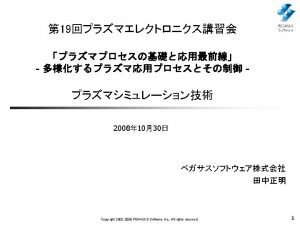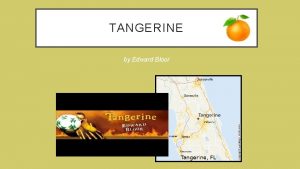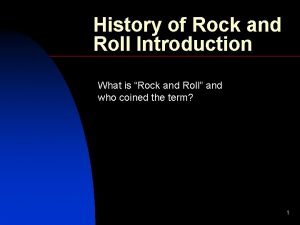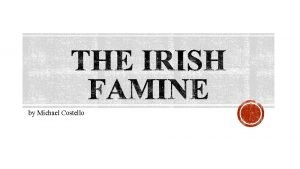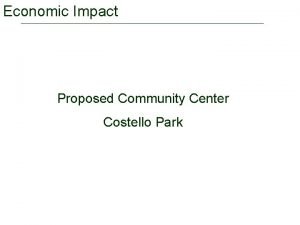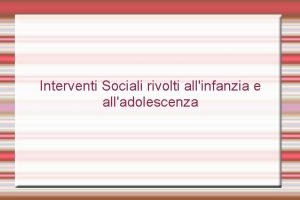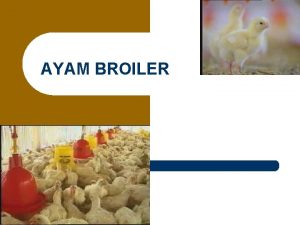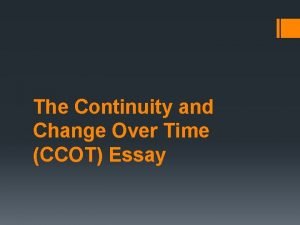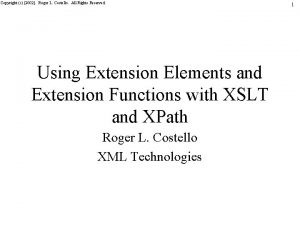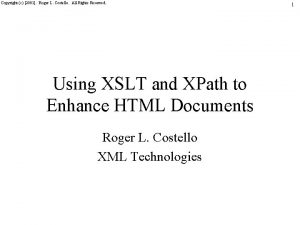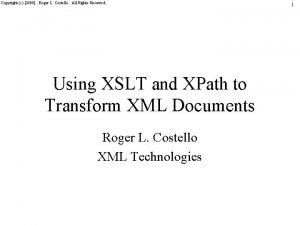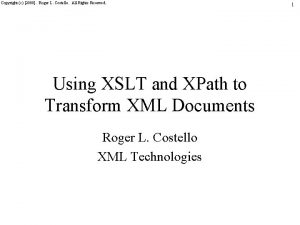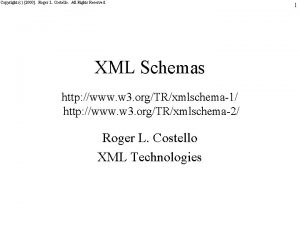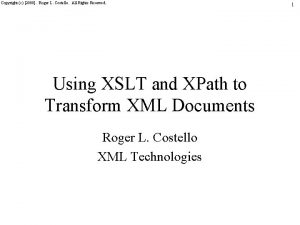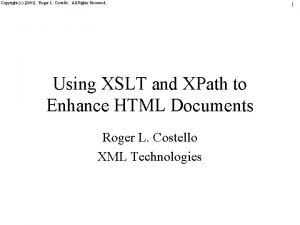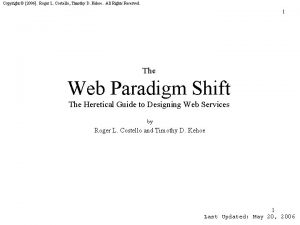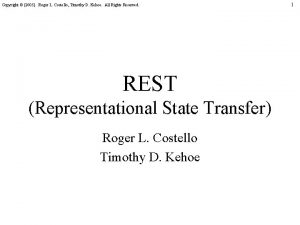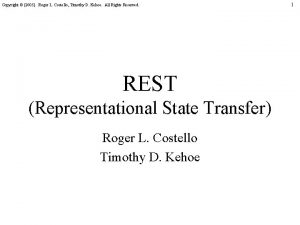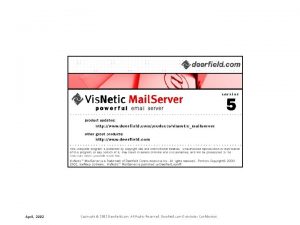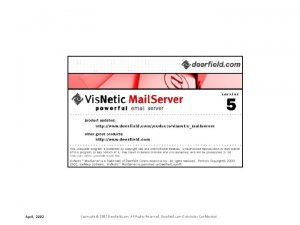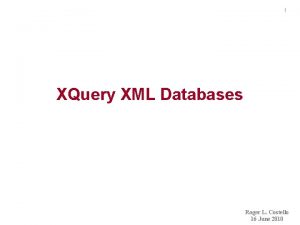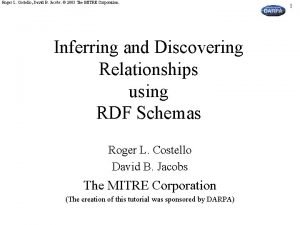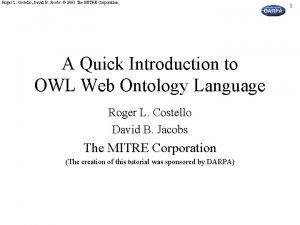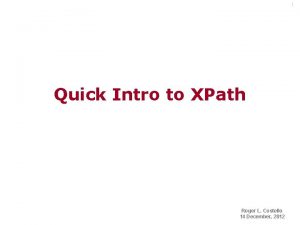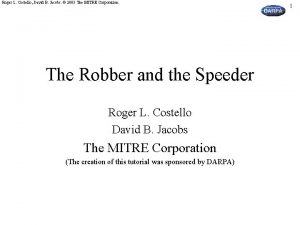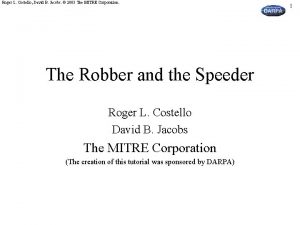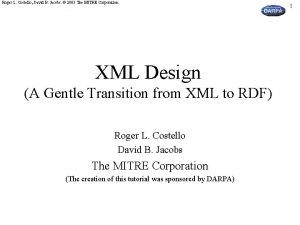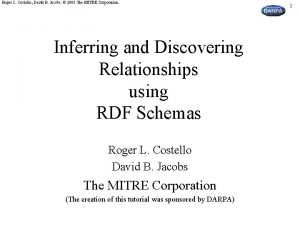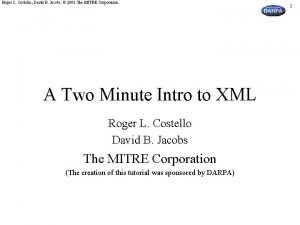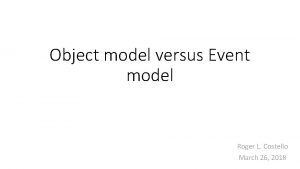Copyright c 2002 Roger L Costello All Rights
![Copyright (c) [2002]. Roger L. Costello. All Rights Reserved. REST (Representational State Transfer) Roger Copyright (c) [2002]. Roger L. Costello. All Rights Reserved. REST (Representational State Transfer) Roger](https://slidetodoc.com/presentation_image_h2/f8f4d5259f0d938f3c198f1c69f6128d/image-1.jpg)
![Copyright (c) [2002]. Roger L. Costello. All Rights Reserved. Acknowledgements • I would like Copyright (c) [2002]. Roger L. Costello. All Rights Reserved. Acknowledgements • I would like](https://slidetodoc.com/presentation_image_h2/f8f4d5259f0d938f3c198f1c69f6128d/image-2.jpg)
![Copyright (c) [2002]. Roger L. Costello. All Rights Reserved. What is REST? • REST Copyright (c) [2002]. Roger L. Costello. All Rights Reserved. What is REST? • REST](https://slidetodoc.com/presentation_image_h2/f8f4d5259f0d938f3c198f1c69f6128d/image-3.jpg)
![4 Copyright (c) [2002]. Roger L. Costello. All Rights Reserved. Why is it called 4 Copyright (c) [2002]. Roger L. Costello. All Rights Reserved. Why is it called](https://slidetodoc.com/presentation_image_h2/f8f4d5259f0d938f3c198f1c69f6128d/image-4.jpg)
![5 Copyright (c) [2002]. Roger L. Costello. All Rights Reserved. Representation State Transfer "Representation 5 Copyright (c) [2002]. Roger L. Costello. All Rights Reserved. Representation State Transfer "Representation](https://slidetodoc.com/presentation_image_h2/f8f4d5259f0d938f3c198f1c69f6128d/image-5.jpg)
![6 Copyright (c) [2002]. Roger L. Costello. All Rights Reserved. Motivation for REST "The 6 Copyright (c) [2002]. Roger L. Costello. All Rights Reserved. Motivation for REST "The](https://slidetodoc.com/presentation_image_h2/f8f4d5259f0d938f3c198f1c69f6128d/image-6.jpg)
![Copyright (c) [2002]. Roger L. Costello. All Rights Reserved. REST - not a Standard Copyright (c) [2002]. Roger L. Costello. All Rights Reserved. REST - not a Standard](https://slidetodoc.com/presentation_image_h2/f8f4d5259f0d938f3c198f1c69f6128d/image-7.jpg)
![Copyright (c) [2002]. Roger L. Costello. All Rights Reserved. REST and the Web • Copyright (c) [2002]. Roger L. Costello. All Rights Reserved. REST and the Web •](https://slidetodoc.com/presentation_image_h2/f8f4d5259f0d938f3c198f1c69f6128d/image-8.jpg)
![Copyright (c) [2002]. Roger L. Costello. All Rights Reserved. Learn by Example • This Copyright (c) [2002]. Roger L. Costello. All Rights Reserved. Learn by Example • This](https://slidetodoc.com/presentation_image_h2/f8f4d5259f0d938f3c198f1c69f6128d/image-9.jpg)
![Copyright (c) [2002]. Roger L. Costello. All Rights Reserved. Parts Depot Web Services • Copyright (c) [2002]. Roger L. Costello. All Rights Reserved. Parts Depot Web Services •](https://slidetodoc.com/presentation_image_h2/f8f4d5259f0d938f3c198f1c69f6128d/image-10.jpg)
![11 Copyright (c) [2002]. Roger L. Costello. All Rights Reserved. The REST way of 11 Copyright (c) [2002]. Roger L. Costello. All Rights Reserved. The REST way of](https://slidetodoc.com/presentation_image_h2/f8f4d5259f0d938f3c198f1c69f6128d/image-11.jpg)
![Copyright (c) [2002]. Roger L. Costello. All Rights Reserved. The REST way of Implementing Copyright (c) [2002]. Roger L. Costello. All Rights Reserved. The REST way of Implementing](https://slidetodoc.com/presentation_image_h2/f8f4d5259f0d938f3c198f1c69f6128d/image-12.jpg)
![Copyright (c) [2002]. Roger L. Costello. All Rights Reserved. Data Returned - Parts List Copyright (c) [2002]. Roger L. Costello. All Rights Reserved. Data Returned - Parts List](https://slidetodoc.com/presentation_image_h2/f8f4d5259f0d938f3c198f1c69f6128d/image-13.jpg)
![Copyright (c) [2002]. Roger L. Costello. All Rights Reserved. The REST way of Implementing Copyright (c) [2002]. Roger L. Costello. All Rights Reserved. The REST way of Implementing](https://slidetodoc.com/presentation_image_h2/f8f4d5259f0d938f3c198f1c69f6128d/image-14.jpg)
![Copyright (c) [2002]. Roger L. Costello. All Rights Reserved. Data Returned - Part <? Copyright (c) [2002]. Roger L. Costello. All Rights Reserved. Data Returned - Part <?](https://slidetodoc.com/presentation_image_h2/f8f4d5259f0d938f3c198f1c69f6128d/image-15.jpg)
![Copyright (c) [2002]. Roger L. Costello. All Rights Reserved. Questions and Answers 16 Q: Copyright (c) [2002]. Roger L. Costello. All Rights Reserved. Questions and Answers 16 Q:](https://slidetodoc.com/presentation_image_h2/f8f4d5259f0d938f3c198f1c69f6128d/image-16.jpg)
![Copyright (c) [2002]. Roger L. Costello. All Rights Reserved. Questions and Answers Q: What Copyright (c) [2002]. Roger L. Costello. All Rights Reserved. Questions and Answers Q: What](https://slidetodoc.com/presentation_image_h2/f8f4d5259f0d938f3c198f1c69f6128d/image-17.jpg)
![Copyright (c) [2002]. Roger L. Costello. All Rights Reserved. Questions and Answers Q: How Copyright (c) [2002]. Roger L. Costello. All Rights Reserved. Questions and Answers Q: How](https://slidetodoc.com/presentation_image_h2/f8f4d5259f0d938f3c198f1c69f6128d/image-18.jpg)
![19 Copyright (c) [2002]. Roger L. Costello. All Rights Reserved. The REST way of 19 Copyright (c) [2002]. Roger L. Costello. All Rights Reserved. The REST way of](https://slidetodoc.com/presentation_image_h2/f8f4d5259f0d938f3c198f1c69f6128d/image-19.jpg)
![20 Copyright (c) [2002]. Roger L. Costello. All Rights Reserved. Submit PO Service (cont. 20 Copyright (c) [2002]. Roger L. Costello. All Rights Reserved. Submit PO Service (cont.](https://slidetodoc.com/presentation_image_h2/f8f4d5259f0d938f3c198f1c69f6128d/image-20.jpg)
![Copyright (c) [2002]. Roger L. Costello. All Rights Reserved. Characteristics of a REST-based Network Copyright (c) [2002]. Roger L. Costello. All Rights Reserved. Characteristics of a REST-based Network](https://slidetodoc.com/presentation_image_h2/f8f4d5259f0d938f3c198f1c69f6128d/image-21.jpg)
![Copyright (c) [2002]. Roger L. Costello. All Rights Reserved. SOAP Version • We have Copyright (c) [2002]. Roger L. Costello. All Rights Reserved. SOAP Version • We have](https://slidetodoc.com/presentation_image_h2/f8f4d5259f0d938f3c198f1c69f6128d/image-22.jpg)
![23 Copyright (c) [2002]. Roger L. Costello. All Rights Reserved. Implementing the Web Services 23 Copyright (c) [2002]. Roger L. Costello. All Rights Reserved. Implementing the Web Services](https://slidetodoc.com/presentation_image_h2/f8f4d5259f0d938f3c198f1c69f6128d/image-23.jpg)
![24 Copyright (c) [2002]. Roger L. Costello. All Rights Reserved. Note about the SOAP 24 Copyright (c) [2002]. Roger L. Costello. All Rights Reserved. Note about the SOAP](https://slidetodoc.com/presentation_image_h2/f8f4d5259f0d938f3c198f1c69f6128d/image-24.jpg)
![Copyright (c) [2002]. Roger L. Costello. All Rights Reserved. Implementing the Web Service using Copyright (c) [2002]. Roger L. Costello. All Rights Reserved. Implementing the Web Service using](https://slidetodoc.com/presentation_image_h2/f8f4d5259f0d938f3c198f1c69f6128d/image-25.jpg)
![Copyright (c) [2002]. Roger L. Costello. All Rights Reserved. Data Returned - Parts List Copyright (c) [2002]. Roger L. Costello. All Rights Reserved. Data Returned - Parts List](https://slidetodoc.com/presentation_image_h2/f8f4d5259f0d938f3c198f1c69f6128d/image-26.jpg)
![Copyright (c) [2002]. Roger L. Costello. All Rights Reserved. Implementing the Web Service using Copyright (c) [2002]. Roger L. Costello. All Rights Reserved. Implementing the Web Service using](https://slidetodoc.com/presentation_image_h2/f8f4d5259f0d938f3c198f1c69f6128d/image-27.jpg)
![Copyright (c) [2002]. Roger L. Costello. All Rights Reserved. Data Returned - Part <? Copyright (c) [2002]. Roger L. Costello. All Rights Reserved. Data Returned - Part <?](https://slidetodoc.com/presentation_image_h2/f8f4d5259f0d938f3c198f1c69f6128d/image-28.jpg)
![Copyright (c) [2002]. Roger L. Costello. All Rights Reserved. Implementing the Web Service using Copyright (c) [2002]. Roger L. Costello. All Rights Reserved. Implementing the Web Service using](https://slidetodoc.com/presentation_image_h2/f8f4d5259f0d938f3c198f1c69f6128d/image-29.jpg)
![Copyright (c) [2002]. Roger L. Costello. All Rights Reserved. Data Returned - PO Acknowledgment Copyright (c) [2002]. Roger L. Costello. All Rights Reserved. Data Returned - PO Acknowledgment](https://slidetodoc.com/presentation_image_h2/f8f4d5259f0d938f3c198f1c69f6128d/image-30.jpg)
![Copyright (c) [2002]. Roger L. Costello. All Rights Reserved. Contrasting REST and SOAP • Copyright (c) [2002]. Roger L. Costello. All Rights Reserved. Contrasting REST and SOAP •](https://slidetodoc.com/presentation_image_h2/f8f4d5259f0d938f3c198f1c69f6128d/image-31.jpg)
![Copyright (c) [2002]. Roger L. Costello. All Rights Reserved. Letter Analogy • • • Copyright (c) [2002]. Roger L. Costello. All Rights Reserved. Letter Analogy • • •](https://slidetodoc.com/presentation_image_h2/f8f4d5259f0d938f3c198f1c69f6128d/image-32.jpg)
![Copyright (c) [2002]. Roger L. Costello. All Rights Reserved. Proxy Servers • Consider this Copyright (c) [2002]. Roger L. Costello. All Rights Reserved. Proxy Servers • Consider this](https://slidetodoc.com/presentation_image_h2/f8f4d5259f0d938f3c198f1c69f6128d/image-33.jpg)
![34 Copyright (c) [2002]. Roger L. Costello. All Rights Reserved. REST and Proxy Servers 34 Copyright (c) [2002]. Roger L. Costello. All Rights Reserved. REST and Proxy Servers](https://slidetodoc.com/presentation_image_h2/f8f4d5259f0d938f3c198f1c69f6128d/image-34.jpg)
![35 Copyright (c) [2002]. Roger L. Costello. All Rights Reserved. REST and Proxy Servers 35 Copyright (c) [2002]. Roger L. Costello. All Rights Reserved. REST and Proxy Servers](https://slidetodoc.com/presentation_image_h2/f8f4d5259f0d938f3c198f1c69f6128d/image-35.jpg)
![36 Copyright (c) [2002]. Roger L. Costello. All Rights Reserved. SOAP and Proxy Servers 36 Copyright (c) [2002]. Roger L. Costello. All Rights Reserved. SOAP and Proxy Servers](https://slidetodoc.com/presentation_image_h2/f8f4d5259f0d938f3c198f1c69f6128d/image-36.jpg)
![37 Copyright (c) [2002]. Roger L. Costello. All Rights Reserved. SOAP and Proxy Servers 37 Copyright (c) [2002]. Roger L. Costello. All Rights Reserved. SOAP and Proxy Servers](https://slidetodoc.com/presentation_image_h2/f8f4d5259f0d938f3c198f1c69f6128d/image-37.jpg)
![38 Copyright (c) [2002]. Roger L. Costello. All Rights Reserved. SOAP and Proxy Servers 38 Copyright (c) [2002]. Roger L. Costello. All Rights Reserved. SOAP and Proxy Servers](https://slidetodoc.com/presentation_image_h2/f8f4d5259f0d938f3c198f1c69f6128d/image-38.jpg)
![Copyright (c) [2002]. Roger L. Costello. All Rights Reserved. Web Intermediaries • A proxy Copyright (c) [2002]. Roger L. Costello. All Rights Reserved. Web Intermediaries • A proxy](https://slidetodoc.com/presentation_image_h2/f8f4d5259f0d938f3c198f1c69f6128d/image-39.jpg)
![40 Copyright (c) [2002]. Roger L. Costello. All Rights Reserved. State Transitions • Let 40 Copyright (c) [2002]. Roger L. Costello. All Rights Reserved. State Transitions • Let](https://slidetodoc.com/presentation_image_h2/f8f4d5259f0d938f3c198f1c69f6128d/image-40.jpg)
![41 Copyright (c) [2002]. Roger L. Costello. All Rights Reserved. State Transitions in a 41 Copyright (c) [2002]. Roger L. Costello. All Rights Reserved. State Transitions in a](https://slidetodoc.com/presentation_image_h2/f8f4d5259f0d938f3c198f1c69f6128d/image-41.jpg)
![Copyright (c) [2002]. Roger L. Costello. All Rights Reserved. State Transitions in a RESTbased Copyright (c) [2002]. Roger L. Costello. All Rights Reserved. State Transitions in a RESTbased](https://slidetodoc.com/presentation_image_h2/f8f4d5259f0d938f3c198f1c69f6128d/image-42.jpg)
![Copyright (c) [2002]. Roger L. Costello. All Rights Reserved. State Transitions in a RESTbased Copyright (c) [2002]. Roger L. Costello. All Rights Reserved. State Transitions in a RESTbased](https://slidetodoc.com/presentation_image_h2/f8f4d5259f0d938f3c198f1c69f6128d/image-43.jpg)
![44 Copyright (c) [2002]. Roger L. Costello. All Rights Reserved. State Transitions in a 44 Copyright (c) [2002]. Roger L. Costello. All Rights Reserved. State Transitions in a](https://slidetodoc.com/presentation_image_h2/f8f4d5259f0d938f3c198f1c69f6128d/image-44.jpg)
![Copyright (c) [2002]. Roger L. Costello. All Rights Reserved. State Transitions in a SOAPbased Copyright (c) [2002]. Roger L. Costello. All Rights Reserved. State Transitions in a SOAPbased](https://slidetodoc.com/presentation_image_h2/f8f4d5259f0d938f3c198f1c69f6128d/image-45.jpg)
![Copyright (c) [2002]. Roger L. Costello. All Rights Reserved. Why don't SOAP Documents Contain Copyright (c) [2002]. Roger L. Costello. All Rights Reserved. Why don't SOAP Documents Contain](https://slidetodoc.com/presentation_image_h2/f8f4d5259f0d938f3c198f1c69f6128d/image-46.jpg)
![Copyright (c) [2002]. Roger L. Costello. All Rights Reserved. Caching (i. e. , performance) Copyright (c) [2002]. Roger L. Costello. All Rights Reserved. Caching (i. e. , performance)](https://slidetodoc.com/presentation_image_h2/f8f4d5259f0d938f3c198f1c69f6128d/image-47.jpg)
![48 Copyright (c) [2002]. Roger L. Costello. All Rights Reserved. REST and Caching http: 48 Copyright (c) [2002]. Roger L. Costello. All Rights Reserved. REST and Caching http:](https://slidetodoc.com/presentation_image_h2/f8f4d5259f0d938f3c198f1c69f6128d/image-48.jpg)
![49 Copyright (c) [2002]. Roger L. Costello. All Rights Reserved. REST and Caching (cont. 49 Copyright (c) [2002]. Roger L. Costello. All Rights Reserved. REST and Caching (cont.](https://slidetodoc.com/presentation_image_h2/f8f4d5259f0d938f3c198f1c69f6128d/image-49.jpg)
![50 Copyright (c) [2002]. Roger L. Costello. All Rights Reserved. SOAP and Caching • 50 Copyright (c) [2002]. Roger L. Costello. All Rights Reserved. SOAP and Caching •](https://slidetodoc.com/presentation_image_h2/f8f4d5259f0d938f3c198f1c69f6128d/image-50.jpg)
![Copyright (c) [2002]. Roger L. Costello. All Rights Reserved. Evolving the Web (Semantic Web) Copyright (c) [2002]. Roger L. Costello. All Rights Reserved. Evolving the Web (Semantic Web)](https://slidetodoc.com/presentation_image_h2/f8f4d5259f0d938f3c198f1c69f6128d/image-51.jpg)
![Copyright (c) [2002]. Roger L. Costello. All Rights Reserved. Generic Interface • A key Copyright (c) [2002]. Roger L. Costello. All Rights Reserved. Generic Interface • A key](https://slidetodoc.com/presentation_image_h2/f8f4d5259f0d938f3c198f1c69f6128d/image-52.jpg)
![Copyright (c) [2002]. Roger L. Costello. All Rights Reserved. Generic Interface (cont. ) • Copyright (c) [2002]. Roger L. Costello. All Rights Reserved. Generic Interface (cont. ) •](https://slidetodoc.com/presentation_image_h2/f8f4d5259f0d938f3c198f1c69f6128d/image-53.jpg)
![Copyright (c) [2002]. Roger L. Costello. All Rights Reserved. Interoperability • The key to Copyright (c) [2002]. Roger L. Costello. All Rights Reserved. Interoperability • The key to](https://slidetodoc.com/presentation_image_h2/f8f4d5259f0d938f3c198f1c69f6128d/image-54.jpg)
![Copyright (c) [2002]. Roger L. Costello. All Rights Reserved. Interoperability (cont. ) • SOAP Copyright (c) [2002]. Roger L. Costello. All Rights Reserved. Interoperability (cont. ) • SOAP](https://slidetodoc.com/presentation_image_h2/f8f4d5259f0d938f3c198f1c69f6128d/image-55.jpg)
![56 Copyright (c) [2002]. Roger L. Costello. All Rights Reserved. Processing the Request/Response Payload 56 Copyright (c) [2002]. Roger L. Costello. All Rights Reserved. Processing the Request/Response Payload](https://slidetodoc.com/presentation_image_h2/f8f4d5259f0d938f3c198f1c69f6128d/image-56.jpg)
![Copyright (c) [2002]. Roger L. Costello. All Rights Reserved. Processing the Request/Response Payload • Copyright (c) [2002]. Roger L. Costello. All Rights Reserved. Processing the Request/Response Payload •](https://slidetodoc.com/presentation_image_h2/f8f4d5259f0d938f3c198f1c69f6128d/image-57.jpg)
![Copyright (c) [2002]. Roger L. Costello. All Rights Reserved. Recommendation • In the context Copyright (c) [2002]. Roger L. Costello. All Rights Reserved. Recommendation • In the context](https://slidetodoc.com/presentation_image_h2/f8f4d5259f0d938f3c198f1c69f6128d/image-58.jpg)
![Copyright (c) [2002]. Roger L. Costello. All Rights Reserved. REST Best Practices 1. Provide Copyright (c) [2002]. Roger L. Costello. All Rights Reserved. REST Best Practices 1. Provide](https://slidetodoc.com/presentation_image_h2/f8f4d5259f0d938f3c198f1c69f6128d/image-59.jpg)
![Copyright (c) [2002]. Roger L. Costello. All Rights Reserved. REST Best Practices (cont. ) Copyright (c) [2002]. Roger L. Costello. All Rights Reserved. REST Best Practices (cont. )](https://slidetodoc.com/presentation_image_h2/f8f4d5259f0d938f3c198f1c69f6128d/image-60.jpg)
![61 Copyright (c) [2002]. Roger L. Costello. All Rights Reserved. References • Paul Prescod 61 Copyright (c) [2002]. Roger L. Costello. All Rights Reserved. References • Paul Prescod](https://slidetodoc.com/presentation_image_h2/f8f4d5259f0d938f3c198f1c69f6128d/image-61.jpg)
- Slides: 61
![Copyright c 2002 Roger L Costello All Rights Reserved REST Representational State Transfer Roger Copyright (c) [2002]. Roger L. Costello. All Rights Reserved. REST (Representational State Transfer) Roger](https://slidetodoc.com/presentation_image_h2/f8f4d5259f0d938f3c198f1c69f6128d/image-1.jpg)
Copyright (c) [2002]. Roger L. Costello. All Rights Reserved. REST (Representational State Transfer) Roger L. Costello XML Technologies Course 1
![Copyright c 2002 Roger L Costello All Rights Reserved Acknowledgements I would like Copyright (c) [2002]. Roger L. Costello. All Rights Reserved. Acknowledgements • I would like](https://slidetodoc.com/presentation_image_h2/f8f4d5259f0d938f3c198f1c69f6128d/image-2.jpg)
Copyright (c) [2002]. Roger L. Costello. All Rights Reserved. Acknowledgements • I would like to thank Paul Prescod for his very helpful comments on improving this tutorial, as well as his outstanding articles on REST. • Also, thanks to the following people for their comments and suggestions: – – – – Sam Ruby Mark Baker Robert Mc. Kinnon Mike Dierken Amy Kazura Kit Lueder Mark Nottingham 2
![Copyright c 2002 Roger L Costello All Rights Reserved What is REST REST Copyright (c) [2002]. Roger L. Costello. All Rights Reserved. What is REST? • REST](https://slidetodoc.com/presentation_image_h2/f8f4d5259f0d938f3c198f1c69f6128d/image-3.jpg)
Copyright (c) [2002]. Roger L. Costello. All Rights Reserved. What is REST? • REST is a term coined by Roy Fielding in his Ph. D dissertation [1] to describe an architecture style of networked systems. [1] http: //www. ebuilt. com/fielding/pubs/dissertation/top. htm 3
![4 Copyright c 2002 Roger L Costello All Rights Reserved Why is it called 4 Copyright (c) [2002]. Roger L. Costello. All Rights Reserved. Why is it called](https://slidetodoc.com/presentation_image_h2/f8f4d5259f0d938f3c198f1c69f6128d/image-4.jpg)
4 Copyright (c) [2002]. Roger L. Costello. All Rights Reserved. Why is it called "Representation State Transfer"? Client http: //www. boeing. com/aircraft/747 Resource Fuel requirements Maintenance schedule. . . Boeing 747. html The Client references a Web resource using a URL. A representation of the resource is returned (in this case as an HTML document). The representation (e. g. , Boeing 747. html) places the client application in a state. The result of the client traversing a hyperlink in Boeing 747. html is another resource is accessed. The new representation places the client application into yet another state. Thus, the client application changes (transfers) state with each resource representation --> Representation State Transfer!
![5 Copyright c 2002 Roger L Costello All Rights Reserved Representation State Transfer Representation 5 Copyright (c) [2002]. Roger L. Costello. All Rights Reserved. Representation State Transfer "Representation](https://slidetodoc.com/presentation_image_h2/f8f4d5259f0d938f3c198f1c69f6128d/image-5.jpg)
5 Copyright (c) [2002]. Roger L. Costello. All Rights Reserved. Representation State Transfer "Representation State Transfer is intended to evoke an image of how a well-designed Web application behaves: a network of web pages (a virtual state-machine), where the user progresses through an application by selecting links (state transitions), resulting in the next page (representing the next state of the application) being transferred to the user and rendered for their use. " - Roy Fielding
![6 Copyright c 2002 Roger L Costello All Rights Reserved Motivation for REST The 6 Copyright (c) [2002]. Roger L. Costello. All Rights Reserved. Motivation for REST "The](https://slidetodoc.com/presentation_image_h2/f8f4d5259f0d938f3c198f1c69f6128d/image-6.jpg)
6 Copyright (c) [2002]. Roger L. Costello. All Rights Reserved. Motivation for REST "The motivation for developing REST was to create an architectural model for how the Web should work, such that it could serve as the guiding framework for the Web protocol standards. REST has been applied to describe the desired Web architecture, help identify existing problems, compare alternative solutions, and ensure that protocol extensions would not violate the core constraints that make the Web successful. " - Roy Fielding
![Copyright c 2002 Roger L Costello All Rights Reserved REST not a Standard Copyright (c) [2002]. Roger L. Costello. All Rights Reserved. REST - not a Standard](https://slidetodoc.com/presentation_image_h2/f8f4d5259f0d938f3c198f1c69f6128d/image-7.jpg)
Copyright (c) [2002]. Roger L. Costello. All Rights Reserved. REST - not a Standard • REST is not a standard. You will not see the W 3 putting out a REST specification. You will not see IBM or Microsoft or Sun selling a REST developer's toolkit. Why? Because REST is just an architectural style. You can't bottle up that style. You can only understand it, and design your Web services in that style. • While REST is not a standard, it does prescribe the use of standards: – – HTTP URL XML/HTML/GIF/JPEG/etc (Resource Representations) text/xml, text/html, image/gif, image/jpeg, etc (Resource Types, MIME Types) 7
![Copyright c 2002 Roger L Costello All Rights Reserved REST and the Web Copyright (c) [2002]. Roger L. Costello. All Rights Reserved. REST and the Web •](https://slidetodoc.com/presentation_image_h2/f8f4d5259f0d938f3c198f1c69f6128d/image-8.jpg)
Copyright (c) [2002]. Roger L. Costello. All Rights Reserved. REST and the Web • The Web is an example of a REST system! • All of those Web services that you have been using all these many years - book ordering services, search services, online dictionary services, etc - are REST-based Web services. • Alas, you have been using REST, building REST services and you didn't even know it. 8
![Copyright c 2002 Roger L Costello All Rights Reserved Learn by Example This Copyright (c) [2002]. Roger L. Costello. All Rights Reserved. Learn by Example • This](https://slidetodoc.com/presentation_image_h2/f8f4d5259f0d938f3c198f1c69f6128d/image-9.jpg)
Copyright (c) [2002]. Roger L. Costello. All Rights Reserved. Learn by Example • This architectural style is best explained with an example. • I will present an example of a company deploying 3 Web services using the REST architectural style, then show they would be deployed using SOAP. • After presenting the example I will contrast the REST and SOAP. 9
![Copyright c 2002 Roger L Costello All Rights Reserved Parts Depot Web Services Copyright (c) [2002]. Roger L. Costello. All Rights Reserved. Parts Depot Web Services •](https://slidetodoc.com/presentation_image_h2/f8f4d5259f0d938f3c198f1c69f6128d/image-10.jpg)
Copyright (c) [2002]. Roger L. Costello. All Rights Reserved. Parts Depot Web Services • Parts Depot, Inc has deployed some web services to enable its customers to: – get a list of parts – get detailed information about a particular part – submit a Purchase Order (PO) 10
![11 Copyright c 2002 Roger L Costello All Rights Reserved The REST way of 11 Copyright (c) [2002]. Roger L. Costello. All Rights Reserved. The REST way of](https://slidetodoc.com/presentation_image_h2/f8f4d5259f0d938f3c198f1c69f6128d/image-11.jpg)
11 Copyright (c) [2002]. Roger L. Costello. All Rights Reserved. The REST way of Implementing the Web Services Response (HTML/XML doc) HTTP GET request Response (HTML/XML doc) HTTP POST PO (HTML/XML) URL to submitted PO URL 1 Parts List HTTP response URL 2 HTTP response URL 3 HTTP response Web Server HTTP GET request Part PO
![Copyright c 2002 Roger L Costello All Rights Reserved The REST way of Implementing Copyright (c) [2002]. Roger L. Costello. All Rights Reserved. The REST way of Implementing](https://slidetodoc.com/presentation_image_h2/f8f4d5259f0d938f3c198f1c69f6128d/image-12.jpg)
Copyright (c) [2002]. Roger L. Costello. All Rights Reserved. The REST way of Implementing the Web Service • Service: Get a list of parts – The web service makes available a URL to a parts list resource. Example, a client would use this URL to get the parts list: • http: //www. parts-depot. com/parts • Note that how the web service generates the parts list is completely transparent to the client. This is loose coupling. – The web service may wish to allow the client to specify whether he/she wants the parts list as an HTML document, or as an XML document. This is how to specify that an XML document is desired: • http: //www. parts-depot. com/parts? flavor=xml 12
![Copyright c 2002 Roger L Costello All Rights Reserved Data Returned Parts List Copyright (c) [2002]. Roger L. Costello. All Rights Reserved. Data Returned - Parts List](https://slidetodoc.com/presentation_image_h2/f8f4d5259f0d938f3c198f1c69f6128d/image-13.jpg)
Copyright (c) [2002]. Roger L. Costello. All Rights Reserved. Data Returned - Parts List <? xml version="1. 0"? > <p: Parts xmlns: p="http: //www. parts-depot. com" xmlns: xlink="http: //www. w 3. org/1999/xlink" xmlns: xsi="http: //www. w 3. org/2001/XMLSchema-instance" xsi: schema. Location= "http: //www. parts-depot. com/parts. xsd"> <Part id="00345" xlink: href="http: //www. parts-depot. com/parts/00345"/> <Part id="00346" xlink: href="http: //www. parts-depot. com/parts/00346"/> <Part id="00347" xlink: href="http: //www. parts-depot. com/parts/00347"/> <Part id="00348" xlink: href="http: //www. parts-depot. com/parts/00348"/> </p: Parts> Note that the parts list has links to get detailed info about each part. This is a key feature of REST. The client transfers from one state to the next by examining and choosing from among the alternative URLs in the response document. 13
![Copyright c 2002 Roger L Costello All Rights Reserved The REST way of Implementing Copyright (c) [2002]. Roger L. Costello. All Rights Reserved. The REST way of Implementing](https://slidetodoc.com/presentation_image_h2/f8f4d5259f0d938f3c198f1c69f6128d/image-14.jpg)
Copyright (c) [2002]. Roger L. Costello. All Rights Reserved. The REST way of Implementing the Web Service • Service: Get detailed information about a particular part – The web service makes available a URL to each part resource. Example, here's how a client requests a specific part: • http: //www. parts-depot. com/parts/00345? flavor=xml 14
![Copyright c 2002 Roger L Costello All Rights Reserved Data Returned Part Copyright (c) [2002]. Roger L. Costello. All Rights Reserved. Data Returned - Part <?](https://slidetodoc.com/presentation_image_h2/f8f4d5259f0d938f3c198f1c69f6128d/image-15.jpg)
Copyright (c) [2002]. Roger L. Costello. All Rights Reserved. Data Returned - Part <? xml version="1. 0"? > <p: Part xmlns: p="http: //www. parts-depot. com" xmlns: xlink="http: //www. w 3. org/1999/xlink" xmlns: xsi="http: //www. w 3. org/2001/XMLSchema-instance" xsi: schema. Location= "http: //www. parts-depot. com/part. xsd"> <Part-ID>00345</Part-ID> <Name>Widget-A</Name> <Description>This part is used within the frap assembly</Description> <Specification xlink: href="http: //www. parts-depot. com/parts/00345/specification"/> <Unit. Cost currency="USD">0. 10</Unit. Cost> <Quantity>10</Quantity> </p: Part> Again observe how this data is linked to still more data - the specification for this part may be found by traversing the hyperlink. Each response document allows the client to drill down to get more detailed information. 15
![Copyright c 2002 Roger L Costello All Rights Reserved Questions and Answers 16 Q Copyright (c) [2002]. Roger L. Costello. All Rights Reserved. Questions and Answers 16 Q:](https://slidetodoc.com/presentation_image_h2/f8f4d5259f0d938f3c198f1c69f6128d/image-16.jpg)
Copyright (c) [2002]. Roger L. Costello. All Rights Reserved. Questions and Answers 16 Q: What if Parts Depot has a million parts, will there be a million static pages? For example: http: //www. parts-depot/parts/000000 http: //www. parts-depot/parts/000001. . . http: //www. parts-depot/parts/999999 A: We need to distinguish between a logical and a physical URL. The above URLs are logical. They express what resource is desired. They do not identify a physical object. The advantage of using logical URLs is that changes to the underlying implementation of the resource will be transparent to clients (that's loose coupling!). Quite likely Parts Depot will store all parts data in a database. Code at the Parts Depot web site will receive each logical URL request, parse it to determine which part is being requested, query the database, and generate the part response document which is returned to the client. Contrast the above logical URLs with these physical URLs: http: //www. parts-depot/parts/000000. html http: //www. parts-depot/parts/000001. html. . . http: //www. parts-depot/parts/999999. html These URLs are clearly pointing to physical (HTML) pages. If there a million parts it will not be very attractive to have a million static pages. Furthermore, changes to how these parts data is represented will result in impact all clients that were using the old representation. So, no, there will not be a million static pages.
![Copyright c 2002 Roger L Costello All Rights Reserved Questions and Answers Q What Copyright (c) [2002]. Roger L. Costello. All Rights Reserved. Questions and Answers Q: What](https://slidetodoc.com/presentation_image_h2/f8f4d5259f0d938f3c198f1c69f6128d/image-17.jpg)
Copyright (c) [2002]. Roger L. Costello. All Rights Reserved. Questions and Answers Q: What if I have a complex query? For example: "show me all parts whose unit cost is under $0. 50 and for which the quantity is less than 10". How would you do that with a simple URL? A: For complex queries Parts Depot will provide a service to allow a client to retrieve a form that would then be filled in by the client. When the client hits "Go" the form would gather up the clients responses and generate a URL based upon the responses. Thus, oftentimes the client doesn't generate the URL (think about using amazon - you start by entering the URL to amazon; from then on you simply fill in forms and the URLs are automatically created for you). 17
![Copyright c 2002 Roger L Costello All Rights Reserved Questions and Answers Q How Copyright (c) [2002]. Roger L. Costello. All Rights Reserved. Questions and Answers Q: How](https://slidetodoc.com/presentation_image_h2/f8f4d5259f0d938f3c198f1c69f6128d/image-18.jpg)
Copyright (c) [2002]. Roger L. Costello. All Rights Reserved. Questions and Answers Q: How are REST services described? A: In brief, REST services may be described using WSDL and/or WRDL (Web Resource Description Language). In the future I will describe more details of how this is accomplished. 18
![19 Copyright c 2002 Roger L Costello All Rights Reserved The REST way of 19 Copyright (c) [2002]. Roger L. Costello. All Rights Reserved. The REST way of](https://slidetodoc.com/presentation_image_h2/f8f4d5259f0d938f3c198f1c69f6128d/image-19.jpg)
19 Copyright (c) [2002]. Roger L. Costello. All Rights Reserved. The REST way of Implementing the Web Service • Service: Submit a Purchase Order (PO) HTTP POST PO. xml conforms to. Web Server – The web service makes available a URL to submit a PO. The client creates a PO instance document which conforms to the PO schema that Parts Depot has designed (and publicized in a WSDL document). The client submits PO. xml as the payload of an HTTP POST. PO. xsd
![20 Copyright c 2002 Roger L Costello All Rights Reserved Submit PO Service cont 20 Copyright (c) [2002]. Roger L. Costello. All Rights Reserved. Submit PO Service (cont.](https://slidetodoc.com/presentation_image_h2/f8f4d5259f0d938f3c198f1c69f6128d/image-20.jpg)
20 Copyright (c) [2002]. Roger L. Costello. All Rights Reserved. Submit PO Service (cont. ) • The PO service responds to the HTTP POST with a URL to the submitted PO. Thus, the client can retrieve the PO any time thereafter. URL HTTP Response Web Server – The PO has become a piece of information which is shared between the client and the server. The shared information (PO) is given an address (URL) by the server and is exposed as a Web service. PO. xml
![Copyright c 2002 Roger L Costello All Rights Reserved Characteristics of a RESTbased Network Copyright (c) [2002]. Roger L. Costello. All Rights Reserved. Characteristics of a REST-based Network](https://slidetodoc.com/presentation_image_h2/f8f4d5259f0d938f3c198f1c69f6128d/image-21.jpg)
Copyright (c) [2002]. Roger L. Costello. All Rights Reserved. Characteristics of a REST-based Network • Client-Server: a pull-based interaction style: consuming components pull representations. • Stateless: each request from client to server must contain all the information necessary to understand the request, and cannot take advantage of any stored context on the server. • Cache: to improve network efficiency responses must be capable of being labeled as cacheable or non-cacheable. • Uniform interface: all resources are accessed with a generic interface (e. g. , HTTP GET, POST, PUT, DELETE). • Named resources - the system is comprised of resources which are named using a URI. • Interconnected resource representations - the representations of the resources are interconnected using URLs, thereby enabling a client to progress from one state to another. 21
![Copyright c 2002 Roger L Costello All Rights Reserved SOAP Version We have Copyright (c) [2002]. Roger L. Costello. All Rights Reserved. SOAP Version • We have](https://slidetodoc.com/presentation_image_h2/f8f4d5259f0d938f3c198f1c69f6128d/image-22.jpg)
Copyright (c) [2002]. Roger L. Costello. All Rights Reserved. SOAP Version • We have taken a look at how Parts Depot may implement its services in a RESTful manner. • Now let's look at how the services may be implemented using SOAP. 22
![23 Copyright c 2002 Roger L Costello All Rights Reserved Implementing the Web Services 23 Copyright (c) [2002]. Roger L. Costello. All Rights Reserved. Implementing the Web Services](https://slidetodoc.com/presentation_image_h2/f8f4d5259f0d938f3c198f1c69f6128d/image-23.jpg)
23 Copyright (c) [2002]. Roger L. Costello. All Rights Reserved. Implementing the Web Services using SOAP envelope Request (XML doc) HTTP POST URL 1 get. Parts. List() Response (XML doc) HTTP POST Response (XML doc) PO (XML doc) URL 1 HTTP Response HTTP POST Web Server Request (XML doc) HTTP Response SOAP Server get. Part(id) URL 1 submit(PO) Response (XML doc) HTTP Response Note the use of the same URL (URL 1) for all transactions. The SOAP Server parses the SOAP message to determine which method to invoke. All SOAP messages are sent using an HTTP POST.
![24 Copyright c 2002 Roger L Costello All Rights Reserved Note about the SOAP 24 Copyright (c) [2002]. Roger L. Costello. All Rights Reserved. Note about the SOAP](https://slidetodoc.com/presentation_image_h2/f8f4d5259f0d938f3c198f1c69f6128d/image-24.jpg)
24 Copyright (c) [2002]. Roger L. Costello. All Rights Reserved. Note about the SOAP URI It is not a SOAP requirement all messages be funneled to the same URL: HTTP POST get. Parts. List() URL 1 SOAP Server get. Part(id) submit(PO) HTTP POST However, it is common among SOAP vendors to follow this practice. For example, here is the URL for all requests when using Apache SOAP: [host]/soap/servlet/messagerouter
![Copyright c 2002 Roger L Costello All Rights Reserved Implementing the Web Service using Copyright (c) [2002]. Roger L. Costello. All Rights Reserved. Implementing the Web Service using](https://slidetodoc.com/presentation_image_h2/f8f4d5259f0d938f3c198f1c69f6128d/image-25.jpg)
Copyright (c) [2002]. Roger L. Costello. All Rights Reserved. Implementing the Web Service using SOAP • Service: Get a list of parts – The client creates a SOAP document that specifies the procedure desired. <? xml version="1. 0"? > <soap: Envelope xmlns: soap="http: //schemas. xmlsoap. org/soap/envelope/"> <soap: Body> <p: get. Parts. List xmlns: p="http: //www. parts-depot. com"/> </soap: Body> </soap: Envelope> Then the client will HTTP POST this document to the SOAP server at: http: //www. parts-depot. com/soap/servlet/messagerouter The SOAP server takes a quick peek into this document to determine what procedure to invoke. 25
![Copyright c 2002 Roger L Costello All Rights Reserved Data Returned Parts List Copyright (c) [2002]. Roger L. Costello. All Rights Reserved. Data Returned - Parts List](https://slidetodoc.com/presentation_image_h2/f8f4d5259f0d938f3c198f1c69f6128d/image-26.jpg)
Copyright (c) [2002]. Roger L. Costello. All Rights Reserved. Data Returned - Parts List <? xml version="1. 0"? > <soap: Envelope xmlns: soap="http: //schemas. xmlsoap. org/soap/envelope/"> <soap: Body> <p: get. Parts. List. Response xmlns: p="http: //www. parts-depot. com"> <Parts> <Part-ID>00345<Part-ID>00346<Part-ID>00347<Part-ID>00348<Part-ID> </Parts> <p: get. Parts. List. Response> </soap: Body> </soap: Envelope> Note the absence of links. Why is this? A URL that points to a SOAP service is meaningless since the URL to a SOAP service is just to the SOAP server. Thus, the URL would need to be supplemented with some indication of which method to invoke at that URL. [Note: of course this response could contain a URL to a REST-ful service. ] 26
![Copyright c 2002 Roger L Costello All Rights Reserved Implementing the Web Service using Copyright (c) [2002]. Roger L. Costello. All Rights Reserved. Implementing the Web Service using](https://slidetodoc.com/presentation_image_h2/f8f4d5259f0d938f3c198f1c69f6128d/image-27.jpg)
Copyright (c) [2002]. Roger L. Costello. All Rights Reserved. Implementing the Web Service using SOAP • Service: Get detailed information about a particular part – The client creates a SOAP document that specifies the procedure desired, along with the part-id parameter. <? xml version="1. 0"? > <soap: Envelope xmlns: soap="http: //schemas. xmlsoap. org/soap/envelope/"> <soap: Body> <p: get. Part xmlns: p="http: //www. parts-depot. com"> <part-id>00345</part-id> </p: get. Part> </soap: Body> </soap: Envelope> Again, the client will HTTP POST this document to the SOAP server at: http: //www. parts-depot. com/soap/servlet/messagerouter Note that this is the same URL as was used when requesting the parts list. The SOAP server peeks into this document to determine what procedure to invoke. 27
![Copyright c 2002 Roger L Costello All Rights Reserved Data Returned Part Copyright (c) [2002]. Roger L. Costello. All Rights Reserved. Data Returned - Part <?](https://slidetodoc.com/presentation_image_h2/f8f4d5259f0d938f3c198f1c69f6128d/image-28.jpg)
Copyright (c) [2002]. Roger L. Costello. All Rights Reserved. Data Returned - Part <? xml version="1. 0"? > <soap: Envelope xmlns: soap="http: //schemas. xmlsoap. org/soap/envelope/"> <soap: Body> <p: get. Part. Response xmlns: p="http: //www. parts-depot. com"> <Part-ID>00345</Part-ID> <Name>Widget-A</Name> <Description>This part is used within the frap assembly</Description> <Unit. Cost currency="USD">0. 10</Unit. Cost> <Quantity>10</Quantity> </p: get. Part. Response> </soap: Body> </soap: Envelope> Again, notice the absence of links. Thus, there is nothing in the response to enable a client to "go to the next level of detail". The information about how to go to the next level of detail must be found out-of-band. 28
![Copyright c 2002 Roger L Costello All Rights Reserved Implementing the Web Service using Copyright (c) [2002]. Roger L. Costello. All Rights Reserved. Implementing the Web Service using](https://slidetodoc.com/presentation_image_h2/f8f4d5259f0d938f3c198f1c69f6128d/image-29.jpg)
Copyright (c) [2002]. Roger L. Costello. All Rights Reserved. Implementing the Web Service using SOAP • Service: Submit a Purchase Order (PO) – The client creates a SOAP document that contains a PO instance document (which conforms to the PO schema that Parts Depot has created) <? xml version="1. 0"? > <soap: Envelope xmlns: soap="http: //schemas. xmlsoap. org/soap/envelope/"> <soap: Body> <p: Purchase. Order xmlns: p="http: //www. parts-depot. com">. . . </p: Purchase. Order> </soap: Body> </soap: Envelope> Once again, the client will HTTP POST this document to the SOAP server at: http: //www. parts-depot. com/soap/servlet/messagerouter Note that this is the same URL as was used with the other two services. The SOAP server peeks into this document to determine what procedure to invoke. 29
![Copyright c 2002 Roger L Costello All Rights Reserved Data Returned PO Acknowledgment Copyright (c) [2002]. Roger L. Costello. All Rights Reserved. Data Returned - PO Acknowledgment](https://slidetodoc.com/presentation_image_h2/f8f4d5259f0d938f3c198f1c69f6128d/image-30.jpg)
Copyright (c) [2002]. Roger L. Costello. All Rights Reserved. Data Returned - PO Acknowledgment <? xml version="1. 0"? > <soap: Envelope xmlns: soap="http: //schemas. xmlsoap. org/soap/envelope/"> <soap: Body> <p: PO-Submittal. Response xmlns: p="http: //www. parts-depot. com"> <PO-ID>x-010123 fjdsk 390 f</PO-ID> </p: PO-Submittal. Response> </soap: Body> </soap: Envelope> Again, notice the absence of links. 30
![Copyright c 2002 Roger L Costello All Rights Reserved Contrasting REST and SOAP Copyright (c) [2002]. Roger L. Costello. All Rights Reserved. Contrasting REST and SOAP •](https://slidetodoc.com/presentation_image_h2/f8f4d5259f0d938f3c198f1c69f6128d/image-31.jpg)
Copyright (c) [2002]. Roger L. Costello. All Rights Reserved. Contrasting REST and SOAP • On the next slides I will contrast REST and SOAP in terms of: – Proxy Servers (Web intermediaries) – Transitioning state in a client application – Caching (i. e. , performance) – Web evolution (semantic Web) – Generic interface (versus custom interface) – Interoperability – Processing the payload 31
![Copyright c 2002 Roger L Costello All Rights Reserved Letter Analogy Copyright (c) [2002]. Roger L. Costello. All Rights Reserved. Letter Analogy • • •](https://slidetodoc.com/presentation_image_h2/f8f4d5259f0d938f3c198f1c69f6128d/image-32.jpg)
Copyright (c) [2002]. Roger L. Costello. All Rights Reserved. Letter Analogy • • • My company has a receiving warehouse. All letters and packages first go there, and from there they are distributed. A SOAP Server is analogous to the receiving warehouse - the SOAP Server receives all incoming SOAP messages and then distributes each message to the appropriate application for processing. However, there is one big difference: – No one in the receiving warehouse is allowed to look inside any letter or package. All decisions about what to do with letters/packages must be made purely by looking at the addressing on the outside. Any attempt to look inside of letters/packages is a violation of Federal Law (U. S. ). – A SOAP Server, on the other hand, is able to "peek inside" the SOAP envelope. In fact, it must do so because the actual target resource is not specified on the outside, but rather, is hidden within the envelope. • • With REST all decisions are made based upon the URL and HTTP method. Thus, REST and SOAP have a fundamental difference in this regard. We will see in the next slides that this causes SOAP to clash with the Web. 32
![Copyright c 2002 Roger L Costello All Rights Reserved Proxy Servers Consider this Copyright (c) [2002]. Roger L. Costello. All Rights Reserved. Proxy Servers • Consider this](https://slidetodoc.com/presentation_image_h2/f8f4d5259f0d938f3c198f1c69f6128d/image-33.jpg)
Copyright (c) [2002]. Roger L. Costello. All Rights Reserved. Proxy Servers • Consider this scenario: – A company has deployed 3 resources - Resource 1, Resource 2, and Resource 3 – A client wishes to access Resource 1 (get a representation of Resource 1) – All client requests go through a proxy server – The proxy server enforces the policy that access to Resource 2 and Resource 3 is allowed. However, Resource 1 is off limits (for example, suppose that Resource 1 is Hotmail, and the client's company policy prohibits accessing Hotmail using the company's lines). 33
![34 Copyright c 2002 Roger L Costello All Rights Reserved REST and Proxy Servers 34 Copyright (c) [2002]. Roger L. Costello. All Rights Reserved. REST and Proxy Servers](https://slidetodoc.com/presentation_image_h2/f8f4d5259f0d938f3c198f1c69f6128d/image-34.jpg)
34 Copyright (c) [2002]. Roger L. Costello. All Rights Reserved. REST and Proxy Servers Resource 1 http: //www. somewhere. org/Resource 1 Proxy Server Web Server Resource 2 “You’re not allowed to access Resource 1” Resource 3
![35 Copyright c 2002 Roger L Costello All Rights Reserved REST and Proxy Servers 35 Copyright (c) [2002]. Roger L. Costello. All Rights Reserved. REST and Proxy Servers](https://slidetodoc.com/presentation_image_h2/f8f4d5259f0d938f3c198f1c69f6128d/image-35.jpg)
35 Copyright (c) [2002]. Roger L. Costello. All Rights Reserved. REST and Proxy Servers (cont. ) • The URL identifies the resource that is desired (e. g. , Resource 1) • The HTTP method identifies the desired operation (e. g, HTTP GET) • A proxy server can decide, based upon the identified resource, and the HTTP method whether or not to allow the operation. Desired resource Accept/reject Method
![36 Copyright c 2002 Roger L Costello All Rights Reserved SOAP and Proxy Servers 36 Copyright (c) [2002]. Roger L. Costello. All Rights Reserved. SOAP and Proxy Servers](https://slidetodoc.com/presentation_image_h2/f8f4d5259f0d938f3c198f1c69f6128d/image-36.jpg)
36 Copyright (c) [2002]. Roger L. Costello. All Rights Reserved. SOAP and Proxy Servers Resource 1 http: //www. somewhere. org/soap-server Proxy Server “I can’t determine if the message is allowed since I don’t know what Resource it is targeting [that information is hidden in the Envelope]” Web Server SOAP Server Resource 2 Resource 3
![37 Copyright c 2002 Roger L Costello All Rights Reserved SOAP and Proxy Servers 37 Copyright (c) [2002]. Roger L. Costello. All Rights Reserved. SOAP and Proxy Servers](https://slidetodoc.com/presentation_image_h2/f8f4d5259f0d938f3c198f1c69f6128d/image-37.jpg)
37 Copyright (c) [2002]. Roger L. Costello. All Rights Reserved. SOAP and Proxy Servers (cont. ) • The URL is not to the target resource, but rather to a SOAP server. This makes it harder, and less likely, for a proxy server to determine which resource is actually being targeted. • The proxy server would need to look inside the SOAP message to determine which resource is being requested. – Further, the proxy server would need to understand the semantics of the message: <? xml version="1. 0"? > <soap: Envelope xmlns: soap="http: //schemas. xmlsoap. org/soap/envelope/"> <soap: Body> <get. Resource xmlns="…"> <id>R 1</id> </get. Resource> </soap: Body> </soap: Envelope> Does this mean that the client is trying to access Resource 1? The proxy server must understand the semantics of every SOAP application!
![38 Copyright c 2002 Roger L Costello All Rights Reserved SOAP and Proxy Servers 38 Copyright (c) [2002]. Roger L. Costello. All Rights Reserved. SOAP and Proxy Servers](https://slidetodoc.com/presentation_image_h2/f8f4d5259f0d938f3c198f1c69f6128d/image-38.jpg)
38 Copyright (c) [2002]. Roger L. Costello. All Rights Reserved. SOAP and Proxy Servers (cont. ) Proxy Server SOAP message "What resource is this SOAP message trying to access? What is it trying to do with the resource? " There are 2 ways to implement the proxy server: 1. Program the proxy server to understand the semantics of each SOAP application that a client will access. This approach is not scalable - for each new SOAP application the proxy server will need to be updated. 2. If all SOAP messages are written in RDF/DAML then it may be possible for the proxy server to dynamically discover the resource/method being requested.
![Copyright c 2002 Roger L Costello All Rights Reserved Web Intermediaries A proxy Copyright (c) [2002]. Roger L. Costello. All Rights Reserved. Web Intermediaries • A proxy](https://slidetodoc.com/presentation_image_h2/f8f4d5259f0d938f3c198f1c69f6128d/image-39.jpg)
Copyright (c) [2002]. Roger L. Costello. All Rights Reserved. Web Intermediaries • A proxy server is one example of a Web intermediary. Other examples are gateways, caches, etc. A typical Web request may be routed through multiple intermediaries. • A Web intermediary will have a much greater chance of making reasonable decisions when a client's request shows, in the clear, the targeted resource, and the method requested is understood. • As we have seen with SOAP both the targeted resource, as well as the requested method is nested within the SOAP envelope, thus making it much more difficult for intermediaries to do their job. 39
![40 Copyright c 2002 Roger L Costello All Rights Reserved State Transitions Let 40 Copyright (c) [2002]. Roger L. Costello. All Rights Reserved. State Transitions • Let](https://slidetodoc.com/presentation_image_h2/f8f4d5259f0d938f3c198f1c69f6128d/image-40.jpg)
40 Copyright (c) [2002]. Roger L. Costello. All Rights Reserved. State Transitions • Let us consider a client application as a state machine - each resource representation that it receives causes it to transition to the next state. State Transition Diagram for a Client Application S 0 Receive Resource 1 Representation S 1 Receive Resource 2 Representation S 2 . . .
![41 Copyright c 2002 Roger L Costello All Rights Reserved State Transitions in a 41 Copyright (c) [2002]. Roger L. Costello. All Rights Reserved. State Transitions in a](https://slidetodoc.com/presentation_image_h2/f8f4d5259f0d938f3c198f1c69f6128d/image-41.jpg)
41 Copyright (c) [2002]. Roger L. Costello. All Rights Reserved. State Transitions in a RESTbased Network Receive Resource 3 b Representation Receive Resource 2 a Representation 3 a 3 b Receive Resource 1 Representation S 0 2 a 2 b 2 c S 2 a S 3 a 4 a 4 b 4 c S 3 b S 1 Each resource representation contains hyperlinks. Following a hyperlink takes the client to the next state. Thus, within the resource representations themselves are pointers to the next states. S 2 b S 2 c
![Copyright c 2002 Roger L Costello All Rights Reserved State Transitions in a RESTbased Copyright (c) [2002]. Roger L. Costello. All Rights Reserved. State Transitions in a RESTbased](https://slidetodoc.com/presentation_image_h2/f8f4d5259f0d938f3c198f1c69f6128d/image-42.jpg)
Copyright (c) [2002]. Roger L. Costello. All Rights Reserved. State Transitions in a RESTbased Network Recall the Parts Depot example. The parts list resource returns this representation: <? xml version="1. 0"? > <p: Parts xmlns: p="http: //www. parts-depot. com" xmlns: xlink="http: //www. w 3. org/1999/xlink" xmlns: xsi="http: //www. w 3. org/2001/XMLSchema-instance" xsi: schema. Location= "http: //www. parts-depot. com/parts. xsd"> <Part id="00345" xlink: href="http: //www. parts-depot. com/parts/00345"/> <Part id="00346" xlink: href="http: //www. parts-depot. com/parts/00346"/> <Part id="00347" xlink: href="http: //www. parts-depot. com/parts/00347"/> <Part id="00348" xlink: href="http: //www. parts-depot. com/parts/00348"/> </p: Parts> This document contains hyperlinks to resources that provide detailed information about each part. When a client application follows one of the hyperlinks it receives a representation of the resource identified by the hyperlink. This transfers the client application to the next state. 42
![Copyright c 2002 Roger L Costello All Rights Reserved State Transitions in a RESTbased Copyright (c) [2002]. Roger L. Costello. All Rights Reserved. State Transitions in a RESTbased](https://slidetodoc.com/presentation_image_h2/f8f4d5259f0d938f3c198f1c69f6128d/image-43.jpg)
Copyright (c) [2002]. Roger L. Costello. All Rights Reserved. State Transitions in a RESTbased Network Question: If I am sitting at a browser then I can understand how the decision is made on which hyperlink to select (my brain decides). But if this is all being done programmatically, without human intervention, then how will the decision be made on which hyperlink to select? Answer: The XML hyperlinking technology is XLink. With this technology in addition to providing a URL to the target resource, you can also provide data about the resource you are linking to (using xlink: role). If the client application is able to understand the semantics of xlink: role then it will be able to make a decision on which resource to choose next. This is ultra cool - the application is dynamically making decisions about what resources to access (it is becoming a self-propelled automata). If the client application is not able to evaluate the xlink: role attribute then the decision will need to be made out-of-band (that is, the decision must have been made when the application was written). 43
![44 Copyright c 2002 Roger L Costello All Rights Reserved State Transitions in a 44 Copyright (c) [2002]. Roger L. Costello. All Rights Reserved. State Transitions in a](https://slidetodoc.com/presentation_image_h2/f8f4d5259f0d938f3c198f1c69f6128d/image-44.jpg)
44 Copyright (c) [2002]. Roger L. Costello. All Rights Reserved. State Transitions in a SOAPbased Network Receive SOAP from Application 3 b Receive SOAP from Application 2 a S 3 a S 2 a Receive SOAP from Application 1 S 0 S 3 b S 1 In a pure SOAP system each SOAP message will be just data, no hyperlinks. Consequently, the decision on which resource to access next must be made out-of-band. S 2 b S 2 c
![Copyright c 2002 Roger L Costello All Rights Reserved State Transitions in a SOAPbased Copyright (c) [2002]. Roger L. Costello. All Rights Reserved. State Transitions in a SOAPbased](https://slidetodoc.com/presentation_image_h2/f8f4d5259f0d938f3c198f1c69f6128d/image-45.jpg)
Copyright (c) [2002]. Roger L. Costello. All Rights Reserved. State Transitions in a SOAPbased Network Recall the Parts Depot example. The parts list resource returns this SOAP document: <? xml version="1. 0"? > <soap: Envelope xmlns: soap="http: //schemas. xmlsoap. org/soap/envelope/"> <soap: Body> <p: get. Parts. List. Response xmlns: p="http: //www. parts-depot. com"> <Parts> <Part-ID>00345<Part-ID>00346<Part-ID>00347<Part-ID>00348<Part-ID> </Parts> <p: get. Parts. List. Response> </soap: Body> </soap: Envelope> The SOAP document contains no hyperlinks. In the Web world this document is an island, cut off from the rest of the Web. Information about "what to do next" must be obtained elsewhere, i. e. , out-of-band. 45
![Copyright c 2002 Roger L Costello All Rights Reserved Why dont SOAP Documents Contain Copyright (c) [2002]. Roger L. Costello. All Rights Reserved. Why don't SOAP Documents Contain](https://slidetodoc.com/presentation_image_h2/f8f4d5259f0d938f3c198f1c69f6128d/image-46.jpg)
Copyright (c) [2002]. Roger L. Costello. All Rights Reserved. Why don't SOAP Documents Contain Hyperlinks? • In a pure SOAP system, that is where all accesses are to SOAP-based Web services, then each SOAP document will be an island. • The reason for this is simple: with SOAP a URL is meaningless by itself. The URL just points to a SOAP server. To be useful the URL must be accompanied by the SOAP message. • Note: the SOAP Working Group is currently working on a way to do SOAP HTTP GET. 46
![Copyright c 2002 Roger L Costello All Rights Reserved Caching i e performance Copyright (c) [2002]. Roger L. Costello. All Rights Reserved. Caching (i. e. , performance)](https://slidetodoc.com/presentation_image_h2/f8f4d5259f0d938f3c198f1c69f6128d/image-47.jpg)
Copyright (c) [2002]. Roger L. Costello. All Rights Reserved. Caching (i. e. , performance) • In a network-based application it is ofterntimes the communications which are the bottleneck. 47
![48 Copyright c 2002 Roger L Costello All Rights Reserved REST and Caching http 48 Copyright (c) [2002]. Roger L. Costello. All Rights Reserved. REST and Caching http:](https://slidetodoc.com/presentation_image_h2/f8f4d5259f0d938f3c198f1c69f6128d/image-48.jpg)
48 Copyright (c) [2002]. Roger L. Costello. All Rights Reserved. REST and Caching http: //www. somewhere. org/Resource 1 Cache Server Web Server “I have a copy in my cache. Here it is. ” 2 a 2 b 2 c The cache shortens the distance that the client must go to get the data, thus speeding up the request. Resource 1
![49 Copyright c 2002 Roger L Costello All Rights Reserved REST and Caching cont 49 Copyright (c) [2002]. Roger L. Costello. All Rights Reserved. REST and Caching (cont.](https://slidetodoc.com/presentation_image_h2/f8f4d5259f0d938f3c198f1c69f6128d/image-49.jpg)
49 Copyright (c) [2002]. Roger L. Costello. All Rights Reserved. REST and Caching (cont. ) • The results of a resource request contains an indication in the HTTP header of whether these results are cacheable (and when the data will become stale). • If the HTTP header says that it is cacheable, then cache servers can make a local copy. • Later, if a client requests the same resource then the client can return a cached copy. Desired resource Cache Server Method = GET Return cached copy Forward request
![50 Copyright c 2002 Roger L Costello All Rights Reserved SOAP and Caching 50 Copyright (c) [2002]. Roger L. Costello. All Rights Reserved. SOAP and Caching •](https://slidetodoc.com/presentation_image_h2/f8f4d5259f0d938f3c198f1c69f6128d/image-50.jpg)
50 Copyright (c) [2002]. Roger L. Costello. All Rights Reserved. SOAP and Caching • When you submit a SOAP message it is always with an HTTP POST, even though the intent of the message may be to "get" data. – So a cache server would not know from the HTTP method whether the client is doing a request. • A SOAP URI is always to the SOAP server, not to the actual target – Consequently, a cache server would not know from the URI what resource is being requested. • Thus, with a SOAP message the cache server cannot determine (1) if data is being requested, nor (2) what resource is being requested. – Conclusion: No caching possible with SOAP! URI to SOAP Server Cache Server Method = POST "I don’t know what is the target resource. Furthermore, I don't even know if the resource is being requested. So, I must forward the request. No caching"
![Copyright c 2002 Roger L Costello All Rights Reserved Evolving the Web Semantic Web Copyright (c) [2002]. Roger L. Costello. All Rights Reserved. Evolving the Web (Semantic Web)](https://slidetodoc.com/presentation_image_h2/f8f4d5259f0d938f3c198f1c69f6128d/image-51.jpg)
Copyright (c) [2002]. Roger L. Costello. All Rights Reserved. Evolving the Web (Semantic Web) • The vision of Tim Berners-Lee is to turn the Web into a semantic Web[1]. • One of the key components of his vision is that every resource on the Web have its own URI. – Axiom 0: Universality 1 • Any resource anywhere can be given a URI – Axiom 0 a: Universality 2 • Any resource of significance should be given a URI. • The REST style is consistent with this vision - every resource has a logical URI. • SOAP URI's are funneled through a single URI to the SOAP server. This is not consistent with the semantic Web vision. [1] http: //www. w 3. org/Design. Issues/Axioms. html 51
![Copyright c 2002 Roger L Costello All Rights Reserved Generic Interface A key Copyright (c) [2002]. Roger L. Costello. All Rights Reserved. Generic Interface • A key](https://slidetodoc.com/presentation_image_h2/f8f4d5259f0d938f3c198f1c69f6128d/image-52.jpg)
Copyright (c) [2002]. Roger L. Costello. All Rights Reserved. Generic Interface • A key feature of REST (and the Web) is that every resource have a generic interface. Namely, access to every resource is accomplished using HTTP GET, POST, PUT, and DELETE. • We have seen how the combination of a URI and a generic method set {URI, method} enables Web components to perform useful work: – Proxy Server(URI, method) -> accept/reject – cache(URI, method) -> forward request/return cached representation 52
![Copyright c 2002 Roger L Costello All Rights Reserved Generic Interface cont Copyright (c) [2002]. Roger L. Costello. All Rights Reserved. Generic Interface (cont. ) •](https://slidetodoc.com/presentation_image_h2/f8f4d5259f0d938f3c198f1c69f6128d/image-53.jpg)
Copyright (c) [2002]. Roger L. Costello. All Rights Reserved. Generic Interface (cont. ) • With SOAP there is no defined set of methods. Each SOAP application is free to define its own set of methods. – Consequently, tools must be customized on a per-application basis. This is not scalable. In the Web, where independent evolution and scalability are of supreme importance, this is not a very attractive idea. 53
![Copyright c 2002 Roger L Costello All Rights Reserved Interoperability The key to Copyright (c) [2002]. Roger L. Costello. All Rights Reserved. Interoperability • The key to](https://slidetodoc.com/presentation_image_h2/f8f4d5259f0d938f3c198f1c69f6128d/image-54.jpg)
Copyright (c) [2002]. Roger L. Costello. All Rights Reserved. Interoperability • The key to interoperability is standardization. The reason why independent resources on the Web are able to interoperate today is because the Web has standardized on: – Addressing and naming resources -> URI – Generic resource interface -> HTTP GET, POST, PUT, DELETE – Resource representations -> HTML, XML, GIF, JPEG, etc – Media types -> MIME types (text/html, text/plain, etc) • These are the standards that REST advocates. 54
![Copyright c 2002 Roger L Costello All Rights Reserved Interoperability cont SOAP Copyright (c) [2002]. Roger L. Costello. All Rights Reserved. Interoperability (cont. ) • SOAP](https://slidetodoc.com/presentation_image_h2/f8f4d5259f0d938f3c198f1c69f6128d/image-55.jpg)
Copyright (c) [2002]. Roger L. Costello. All Rights Reserved. Interoperability (cont. ) • SOAP depends much more on customization: – Addressing and naming resources -> each SOAP message provides its own unique method of naming a resource – Resource interface -> each SOAP application defines its own interface 55
![56 Copyright c 2002 Roger L Costello All Rights Reserved Processing the RequestResponse Payload 56 Copyright (c) [2002]. Roger L. Costello. All Rights Reserved. Processing the Request/Response Payload](https://slidetodoc.com/presentation_image_h2/f8f4d5259f0d938f3c198f1c69f6128d/image-56.jpg)
56 Copyright (c) [2002]. Roger L. Costello. All Rights Reserved. Processing the Request/Response Payload • With both REST and SOAP you need prior agreement on the semantics of the data. <? xml version="1. 0"? > <p: Parts xmlns: p="http: //www. parts-depot. com" xmlns: xlink="http: //www. w 3. org/1999/xlink" xmlns: xsi="http: //www. w 3. org/2001/XMLSchema-instance" xsi: schema. Location= "http: //www. parts-depot. com/parts. xsd"> <Part id="00345" xlink: href="http: //www. parts-depot. com/parts/00345"/> <Part id="00346" xlink: href="http: //www. parts-depot. com/parts/00346"/> <Part id="00347" xlink: href="http: //www. parts-depot. com/parts/00347"/> <Part id="00348" xlink: href="http: //www. parts-depot. com/parts/00348"/> </p: Parts> <? xml version="1. 0"? > <soap: Envelope xmlns: soap="http: //schemas. xmlsoap. org/soap/envelope/"> <soap: Body> <p: get. Parts. List. Response xmlns: p="http: //www. parts-depot. com"> <Parts> <Part-ID>00345<Part-ID>00346<Part-ID>00347<Part-ID>00348<Part-ID> </Parts> <p: get. Parts. List. Response> </soap: Body> </soap: Envelope> With both REST and SOAP client applications will need to understand these responses.
![Copyright c 2002 Roger L Costello All Rights Reserved Processing the RequestResponse Payload Copyright (c) [2002]. Roger L. Costello. All Rights Reserved. Processing the Request/Response Payload •](https://slidetodoc.com/presentation_image_h2/f8f4d5259f0d938f3c198f1c69f6128d/image-57.jpg)
Copyright (c) [2002]. Roger L. Costello. All Rights Reserved. Processing the Request/Response Payload • Note: if the payload is in the format of RDF or DAML then the client application may be able to dynamically learn the meaning of the response data. • As we saw earlier, with REST there are links to the next state built within each response. We hinted earlier at how a client application may be able to reason dynamically about which link to traverse. Thus, dynamic learning of response data combined with dynamic reasoning of link traversals would yield a self-reasoning automata. This is the next step of the Web! 57
![Copyright c 2002 Roger L Costello All Rights Reserved Recommendation In the context Copyright (c) [2002]. Roger L. Costello. All Rights Reserved. Recommendation • In the context](https://slidetodoc.com/presentation_image_h2/f8f4d5259f0d938f3c198f1c69f6128d/image-58.jpg)
Copyright (c) [2002]. Roger L. Costello. All Rights Reserved. Recommendation • In the context of the Web, the REST approach is the preferred and most cost-effective architectural style for implementing services due to its scalability, its ability to allow dynamic connectivity without prior planning, its ability to enable independent evolution of clients and services, and its built-in support for caching and security. • There are several major problems with using SOAP in the Web environment: – – – • • The resource being targeted is not known simply from the URL. It is hidden within the SOAP message. The method being invoked is not known from the HTTP method. It is also hidden within the SOAP message. The set of methods is completely arbitrary. Every SOAP application is free to define its own set of methods. As we have discussed these problems create an impedance mismatch with today's Web SOAP messages cannot be utilized by proxy servers, cache servers, etc. The lack of URLs within SOAP messages is very foreign to the Web, and isolates itself from the Web. Finally, the evolution of the Web is where every resource is identified with a URI. SOAPs clumping of resources behind a single URI is contrary to the Web vision. So what is the role of SOAP? SOAP is best utilized in closed systems (systems where all participants are known beforehand). In a closed system each participant can be customized to understand the APIs of the other participants and can be optimized for maximum efficiency. 58
![Copyright c 2002 Roger L Costello All Rights Reserved REST Best Practices 1 Provide Copyright (c) [2002]. Roger L. Costello. All Rights Reserved. REST Best Practices 1. Provide](https://slidetodoc.com/presentation_image_h2/f8f4d5259f0d938f3c198f1c69f6128d/image-59.jpg)
Copyright (c) [2002]. Roger L. Costello. All Rights Reserved. REST Best Practices 1. Provide a URI for each resource that you want (or will want) exposed. This is consistent with Tim Berners-Lee's axioms for the Web, as well as the W 3 TAG recommendations. 2. Prefer URIs that are logical over URIs that are physical. For example: Prefer: http: //www. boeing. com/airplanes/747 Over: http: //www. boeing. com/airplanes/747. html Logical URIs allow the resource implementation to change without impacting client applications. 3. As a corollary to (2) use nouns in the logical URI, not verbs. Resources are "things" not "actions". 4. Make all HTTP GETs side-effect free. Doing so makes the request "safe". 5. Use links in your responses to requests! Doing so connects your response with other data. It enables client applications to be "self-propelled". That is, the response itself contains info about "what's the next step to take". Contrast this to responses that do not contain links. Thus, the decision of "what's the next step to take" must be made out-of-band. 6. Minimize the use of query strings. For example: Prefer: http: //www. parts-depot. com/parts/00345 Over: http: //www. parts-depot. com/parts? part-id=00345 Rationale: the relationship between 'parts' and '00345' is clear, and you can instantiate subresources of '00345' easily; this is not possible if that information is tucked away in a query string. 59
![Copyright c 2002 Roger L Costello All Rights Reserved REST Best Practices cont Copyright (c) [2002]. Roger L. Costello. All Rights Reserved. REST Best Practices (cont. )](https://slidetodoc.com/presentation_image_h2/f8f4d5259f0d938f3c198f1c69f6128d/image-60.jpg)
Copyright (c) [2002]. Roger L. Costello. All Rights Reserved. REST Best Practices (cont. ) 7. Use the slash "/" in a URI to represent a parent-child, whole-part relationship. 8. Use a "gradual unfolding methodology" for exposing data to clients. That is, a resource representation should provide links to obtain more details. 9. Always implement a service using HTTP GET when the purpose of the service is to allow a client to retrieve a resource representation, i. e. , don't use HTTP POST. 60
![61 Copyright c 2002 Roger L Costello All Rights Reserved References Paul Prescod 61 Copyright (c) [2002]. Roger L. Costello. All Rights Reserved. References • Paul Prescod](https://slidetodoc.com/presentation_image_h2/f8f4d5259f0d938f3c198f1c69f6128d/image-61.jpg)
61 Copyright (c) [2002]. Roger L. Costello. All Rights Reserved. References • Paul Prescod has written several excellent articles on REST: – Second Generation Web Services • http: //www. xml. com/pub/a/2002/02/06/rest. html – REST and the Real World • http: //www. xml. com/pub/a/2002/02/20/rest. html – SOAP, REST and Interoperability • http: //www. prescod. net/rest/standardization. html – Evaluating XML for Protocol Control Data • http: //www. prescod. net/xml/envelopes/
 Copyright 2015 all rights reserved
Copyright 2015 all rights reserved Copyright 2015 all rights reserved
Copyright 2015 all rights reserved Dell all rights reserved copyright 2009
Dell all rights reserved copyright 2009 Copyright © 2018 all rights reserved
Copyright © 2018 all rights reserved Copyright 2002
Copyright 2002 Copyright 2002
Copyright 2002 Methadone clinic durango co
Methadone clinic durango co Joey costello tangerine
Joey costello tangerine Elvis costello scaruffi
Elvis costello scaruffi Philippa costello
Philippa costello Costello landscaping
Costello landscaping Michael costello ireland
Michael costello ireland Dianne costello
Dianne costello Costello park
Costello park Negative rights vs positive rights
Negative rights vs positive rights Littoral rights vs riparian rights
Littoral rights vs riparian rights Duties towards self
Duties towards self Legal rights and moral rights
Legal rights and moral rights What is negative right
What is negative right Negative rights
Negative rights Positive rights vs negative rights
Positive rights vs negative rights Negative right
Negative right Draw three noncollinear points j k and l
Draw three noncollinear points j k and l Specification by example
Specification by example All rights reserved sentence
All rights reserved sentence Freesound content licence
Freesound content licence Confidential all rights reserved
Confidential all rights reserved All rights reserved example
All rights reserved example 2012 pearson education inc
2012 pearson education inc Microsoft corporation. all rights reserved.
Microsoft corporation. all rights reserved. Microsoft corporation. all rights reserved.
Microsoft corporation. all rights reserved. Microsoft corporation. all rights reserved.
Microsoft corporation. all rights reserved. Pearson education inc. all rights reserved
Pearson education inc. all rights reserved Warning all rights reserved
Warning all rights reserved C all rights reserved
C all rights reserved All rights reserved formula
All rights reserved formula Warning all rights reserved
Warning all rights reserved Confidential all rights reserved
Confidential all rights reserved Microsoft corporation. all rights reserved
Microsoft corporation. all rights reserved 2010 pearson education inc
2010 pearson education inc Gssllc
Gssllc Copyright 2010 pearson education inc
Copyright 2010 pearson education inc 2010 pearson education inc
2010 pearson education inc Confidential all rights reserved
Confidential all rights reserved Confidential all rights reserved
Confidential all rights reserved Love all serve all
Love all serve all Interventi sociali rivolti alla persona
Interventi sociali rivolti alla persona Crucified laid behind the stone
Crucified laid behind the stone I work all night
I work all night All to one reduction
All to one reduction Sistem all in all out
Sistem all in all out Guyon csatorna
Guyon csatorna Silent night holy night all is calm all is bright
Silent night holy night all is calm all is bright Jesus lamb of god worthy is your name
Jesus lamb of god worthy is your name All of you is more than enough for all of me
All of you is more than enough for all of me She's all states and all princes i nothing else is
She's all states and all princes i nothing else is What height of love what depth of peace
What height of love what depth of peace Above all powers above all kings
Above all powers above all kings Brady and weil 2002
Brady and weil 2002 May 2002 calendar
May 2002 calendar 14/4/2002
14/4/2002 Continuity and change thesis
Continuity and change thesis




